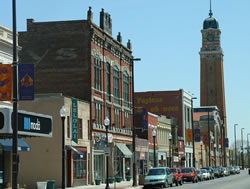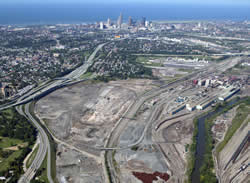 |

A central focus of the Citywide Plan?s retail strategy is to re-establish the competitiveness of Cleveland?s neighborhood retail districts by building upon their traditional strengths as pedestrian-oriented, mixed-use districts with distinctive architectural character. [West 25th Street in Ohio City] | RETAIL
GOAL: Provide Cleveland residents with a broad range of high quality, conveniently located retail shopping opportunities
Issues
Recent years have seen a marked improvement in shopping opportunities in many Cleveland neighborhoods, with the development of contemporary shopping centers and the renovation of historic retail buildings through the City’s Storefront Renovation Program. Nonetheless, Clevelanders remain underserved with respect to the quality and variety of shopping opportunities available in their neighborhoods and in their city. Studies show that Cleveland residents spend over a billion dollars a year in retail stores outside the City – thirty-three cents on every dollar spent on retail purchases.
As new and renovated housing has risen in Cleveland’s neighborhoods, there is a growing mismatch between the increased spending power of residents and the lesser quality and variety of the retail shopping that serves their neighborhoods. The lack of a full range of quality retailing, along with the poor physical condition of some retail makes these otherwise attractive districts, neighborhoods less desirable as places to live.
These issues and others, as highlighted below, must be addressed if Cleveland is to meet its goal to provide all Cleveland residents with a broad range of high-quality retailing.
- poor-quality and limited variety of retailing in many neighborhoods
- mismatch between residents’ spending power and retail shopping opportunities
- unattractive “streetscapes,” signage and storefronts
- retail districts lacking distinctive identities, consistent business hours, joint marketing, etc.
- lack of convenient parking and transit options
- intrusion of auto-oriented development into pedestrian-oriented districts
- sparse retailing and vacant building and lots along major streets
- safety problems and perceptions
- absence of “big draw” retail anchors
- lack of assembled land for large-scale retail development
- ability of locally-owned businesses to compete with national chains
|
|

Strategically located large-scale shopping centers can complement services offered in traditional urban retail districts. [site of Steelyard Commons shopping center] |
Policies
- Building on Strengths. Re-establish the competitiveness of Cleveland’s neighborhood retail districts by building upon their traditional strengths as pedestrian-oriented, mixed-use districts with distinctive architectural character.
- Preservation. Give priority to renovation and infill development, as opposed to large-scale new development, as the principal means of providing competitive retail shopping in Cleveland.
- Building Smart. Strategically locate and design a limited number of large-scale shopping centers in a manner that will stem the outflow of retail spending from the City of Cleveland, while complementing the City’s traditional retail districts.
- Consolidating. Consolidate retail shopping to create and reinforce mixed-use “town centers” that serve as focal points of neighborhood activity.
- Niche Marketing. Transform selected retail districts into regional attractions by clustering stores around common themes – including arts and culture, ethnic identities, antiques, and recreation and scenic resources.
- Tapping the Market. Improve the quantity and quality of retailing in Cleveland neighborhoods by tapping into the hidden market that is often overlooked by national retailers, particularly in neighborhoods with large numbers of minorities and immigrants.
- Creating Wealth. Maximize opportunities for Cleveland residents to own and operate retail businesses in the City.
- Connecting to Transit. Link new and revitalized retail development to public transit, as well as to bicycle routes and cyclist amenities.
- Building Safe. Design retail developments to maximize public safety, and work with merchant and community organizations to ensure ongoing safety.
- Streetscape. Improve the appearance and vitality of retail district “streetscapes” through use of public art, banners and signs, benches, street trees, decorative paving, underground wiring, sidewalk cafes, etc.
- Parking. Develop strategically located shared parking lots and garages in neighborhood retail districts that are under-served by parking.
|
Continue to the Next Section: Goals & Policies: Economic Development |
 |





